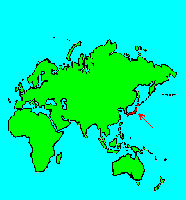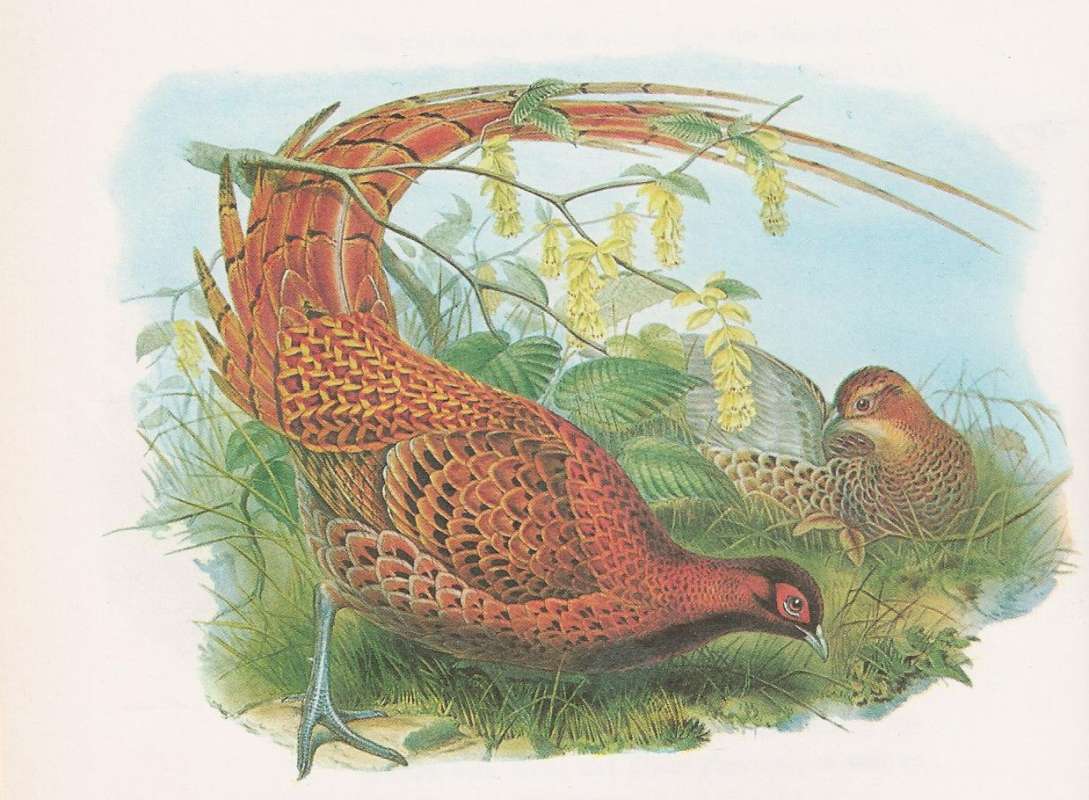SPECIES INFO
Copper pheasant (Syrmaticus soemmerringii) is native to Japan. Mark Brazil noted in 1991 that this was probably gone from Hokkaido, but still present on Honshu, Shikoku, and Kyushu. It was primarily found in hardwood and conifer forests. The 50 inch male is truly copper colored throughout, but marked with white marks on the body and wings, and black and white bands on the tail. The 22 inch female is dark brown above, marked with white, and the female has a white breast marked with brown.
The Japanese copper pheasant has 5 listed subspecies. Three of these (scintillans, subrufus, and intermedius) are found on Honshu. The latter two are also found on Shikoku. The subspecies soemmerringi and ijimae are both found on Kyushu.
In 1991 Mark Brazil noted this species was once very common with over one million shootings per year, but recently has declined. This has been protected since 1976.The pheasant genus Syrmaticus is found from northern India through China and further east to Japan. There are 5 species in this genus. Four of these species are found in China and Taiwan, and one species is found in Japan. The males of these species have long to very long tails. The Chinese species are from 32 inches in length to 72 inches. The Japanese species can reach about 50 inches. These pheasants are close in appearance to the common pheasant genus, Phasianus.
Pheasant (sub)family (Family Phasianidae) contains the true pheasants, chickens, and peafowls. (Different authors treat this and related groups differently. Some place everything in the family Phasianidae, and others divide the family Phasianidae into several different families. Herein we treat the pheasants, quails, grouse, and partridges as separate families.) Herein we treat the pheasants, quails, grouse, and partridges as separate families.) We have counted 51 species and another 5 additional subspecies of true pheasants. With a few exceptions the vast majority of the true pheasants are native to eastern Asia and south into Southeast Asia.
Included in this group of some of the largest and most beautiful exotic birds known. Many species are ground dwellers and run from danger as opposed to taking flight. Many species are sought by amateur and professional hunters.
Fowl group (Galliformes order) contains the various chickens and turkey-like birds of the world. There are about 240 different species of fowl known. Many of the wild species are endangered. Several species such as the domesticated chicken and turkey are main food sources in the world. Most fowl are grain eaters and spend a good portion of their life searching for food on the ground. Select species have been domesticated for their beauty and/or edibility, others are considered good game birds.
Aves contains about 8,650 different species of living birds known to science. Each year about one new species is discovered in some remote rain forest or remote island. In addition, scientists have been raising many subspecies to full species status which may raise the species count to 10,000. Birdlife recognizes 10,027 species as of 2011.
However, each year about one species goes extinct. The rate of extinction is increasing, and the rate of new discovery is decreasing, so that the number of bird species will soon begin to decline rapidly. Although different taxonomists would organize the birds differently, there are approximately twenty-seven orders of birds. These orders are broken down into about one hundred and fifty-five different families.
Recent research of the genetic structure of some of the shore birds and owls would indicate that the present organization of orders and families should have some modification.
The birds are a worldwide group of animals that are characterized by having the front limbs modified into wings that are used for flying. Perhaps the most unique feature of the birds is the feathers. These feathers are made up of a central support called a quill and a series of small filaments that are hooked together as barbs.
For many years it was believed that Archaeopteryx discovered in Bavaria was the oldest bird from about 150 million years ago. However, in l986, Sankar Chattterjee, a Texas paleontologist, reportedly discovered a bird in the genus Protoavis that lived about 225 million years ago.
When this project was begun in 1978, we used Austin & Singer for bird taxonomy. Since then, we have adopted many changes, but have kept some older concepts that are still found widely in the literature. Recently, we have used Clements and Howard & Moore. Very recently, we have used Monroe and Sibley for the higher taxonomy of the perching birds.
Backboned Animals (Phylum Chordata) are the most advanced group of animals on earth. These animals are characterized by having a spinal cord or backbone. Most members have a clearly defined brain that controls the organism through a spinal cord. Fish, amphibians, reptiles, birds, and mammals are in this phylum.
Currently, some taxonomists believe that the fish should be divided into two groups (sharks and regular fishes) and that there are some other primitive groups in the phylum such as hagfish or lampreys.
Animal Kingdom contains numerous organisms that feed on other animals or plants. Included in the animal kingdom are the lower marine invertebrates such as sponges and corals, the jointed legged animals such as insects and spiders, and the backboned animals such as fish, amphibians, reptiles, birds, and mammals.


